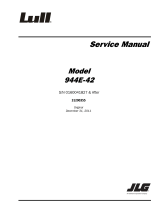
Table of Contents
iii3121851
4.7 Attachment Operation ........................................................4-11
Carriage w/Forks...........................................................4-12
Truss Boom...................................................................4-13
Side Shift Carriage........................................................4-14
Bucket ...........................................................................4-16
Fork Extension ..............................................................4-18
Fork Hook .....................................................................4-20
Adjustable Truss Boom.................................................4-21
4.8 Hitch Options .....................................................................4-22
Mechanical Hitch...........................................................4-22
Hydraulic Hitch..............................................................4-23
Section 5 - Emergency Procedures
5.1 Towing a Disabled Product..................................................5-1
Moving Short Distances ..................................................5-1
Moving Longer Distances ...............................................5-1
5.2 Emergency Lowering of Boom.............................................5-2
Electronic Control Unit Failure ........................................5-3
Engine Failure.................................................................5-4
5.3 Cab Emergency Exit ............................................................5-6
Section 6 - Lubrication and Maintenance
6.1 Introduction ..........................................................................6-1
Clothing and Safety Gear................................................6-1
6.2 General Maintenance Instructions .......................................6-2
6.3 Service and Maintenance Schedules...................................6-3
8 & 1st 50 Hour Maintenance Schedule .........................6-3
50, 250 & 500 Hour Maintenance Schedule ...................6-4
1000 & 1500 Hour Maintenance Schedule .....................6-5
6.4 Lubrication Schedules .........................................................6-6
8 Hour Lubrication Schedule...........................................6-6
50 Hour Lubrication Schedule.........................................6-7
6.5 Operator Maintenance Instructions......................................6-8
Fuel System ....................................................................6-8
Air Intake System..........................................................6-10
Engine Oil .....................................................................6-12
Brake System................................................................6-13
Hydraulic Oil..................................................................6-14
Tires ..............................................................................6-15
Transmission Oil ...........................................................6-16
Engine Cooling System.................................................6-17
Battery...........................................................................6-18





















